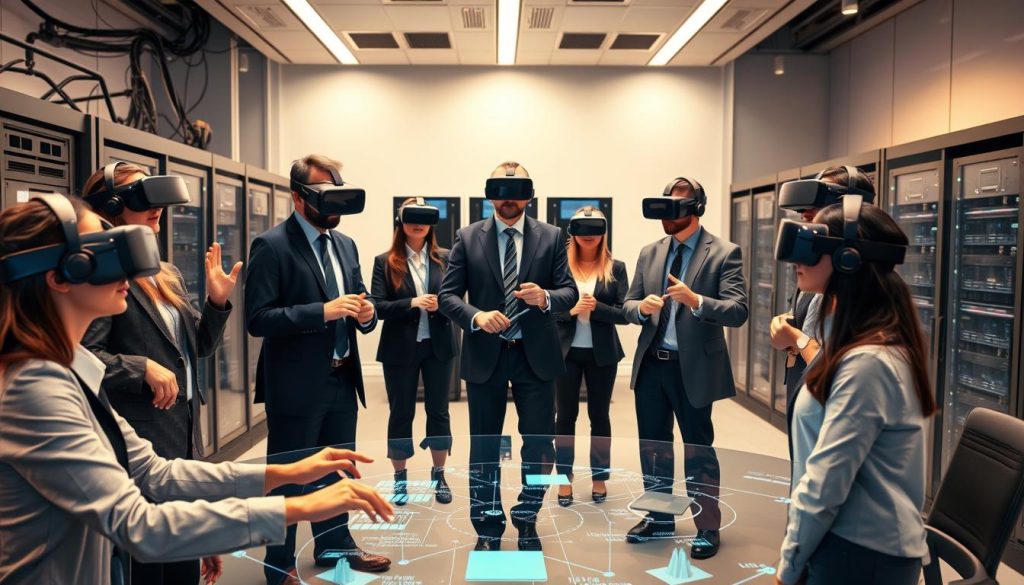Immersive tech is shifting fast from novelty to a core tool for business and education. Global market figures show dramatic growth, and leaders are reworking roadmaps to match new opportunities.
Enterprise adoption now drives many programs. Companies use immersive training, safer simulations, and faster product cycles to unlock clear ROI. That shift moves pilots into funded, repeatable workstreams.
Hardware improvements, better displays, and lighter headsets make experiences more practical for daily use. Software platforms and spatial computing expand applications for collaboration and content at scale.
Key enablers such as AI, 5G, and WebAR lower latency and broaden access. These layers help industries from healthcare and manufacturing to retail and gaming adopt solutions that solve real problems.
The report will highlight market momentum, enterprise cases, and practical guidance to help teams sequence investments across years. Companies that act early and scale what works can gain a clear business edge.
Market outlook: where VR is headed next
Data from recent forecasts pushes immersive offerings from niche demos into repeatable enterprise workflows.
AR/VR combined rose from roughly $30B in 2022 and is forecast to top $520B by 2031. VR alone may reach about $123.06B by 2032 at a near 29% CAGR. These figures change planning for teams and budgets over multiple years.
From novelty to necessity: enterprise adoption accelerates growth
Companies are standardizing headsets and platforms to move pilots into production. That standardization makes training, remote assist, and product reviews repeatable across teams.
Consolidation will favor platforms with device management, security controls, and analytics. These capabilities let firms scale operations while meeting compliance needs.
AR/VR market trajectories and planning implications
Leaders should treat the next several years as a runway for hiring, vendor selection, and content pipelines. Clear use cases—onboarding, safety drills, and remote support—make it easier to measure return and align spend with business goals.
- Industries like healthcare, manufacturing, and education drive current demand for learning and safety applications.
- Consumer interest raises expectations for workforce tools and customer experiences.
- Investments in optics, compute, and networks will compound growth as headsets get more capable.
| Metric | 2022 | 2031–2032 |
|---|---|---|
| AR/VR combined | $30B | $520B (2031) |
| VR alone | — | $123.06B (2032) |
| Key industries | Healthcare, Manufacturing, Education | Expanded enterprise deployments, standardized platforms |
Start with quick wins like compliance modules, then schedule larger applications over years. Choose partners aligned to regulated workflows to reduce integration friction and keep iterations fast.
Future of virtual reality
Short-term upgrades will tighten the gap between demo-grade headsets and tools teams actually use every day.
Near-term means incremental wins: better ergonomics, clearer pass-through MR, and growing app catalogs. These changes improve comfort and raise engagement for users and consumers. Enterprises get lower friction when rolling pilots into repeatable programs.
Mid-term signals point to larger platform shifts: AI co-pilots inside experiences, fuller spatial computing, and standardized device management that eases procurement and security. Those shifts make development and deployment more predictable across environments.
- Consumers: intuitive interactions and richer content variety that boost everyday adoption.
- Enterprise: admin controls, services ecosystems, and procurement options that cut operational risk.
Map use cases by horizon: near-term wins include compliance learning and remote support. Mid-term wins expand to digital twins, real-time collaboration across sites, and AI-personalized instruction.
Technologies like eye tracking, foveated rendering, and spatial mapping already enhance the experience today. Teams should pilot narrowly scoped cases now, gather feedback from consumers and internal users, and use those insights to shape mid-term investments.
Hardware breakthroughs: headsets, displays, and accessories shaping experiences
New optics, sensors, and accessories are making immersive sessions clearer, lighter, and more practical. These shifts matter for teams that run design reviews, engineering demos, training, and gaming pilots.
Apple Vision Pro, Meta, and Pimax: fidelity and tracking gains
vision pro raised the ceiling on visual fidelity and tracking, enabling precise inspection for product design and engineering tasks. Pimax pushes retina-level displays that improve clarity for high-resolution work and premium gaming experiences.
Qualcomm’s newer chipsets also power standalone headsets, cutting tethering and simplifying deployment for frontline training and field use.
Comfort and ergonomics: lighter devices reduce fatigue
Lightweight engineering in Bigscreen Beyond and MeganeX improves weight distribution. That reduces strain for users during long sessions and keeps teams productive without losing capability.
Immersion add-ons: haptics, spatial audio, and locomotion
Haptic gloves, suits, and armbands translate touch and resistance into meaningful feedback. This supports safer, more realistic training scenarios.
Spatial audio enhances presence and situational awareness, guiding attention in collaborative simulations and entertainment.
Locomotion tools like treadmills and specialized shoes can cut motion sickness and expand practice for movement-heavy tasks. Yet they add cost and space needs, so teams should weigh benefits versus total cost of ownership.
- Displays and optics: wider field of view and reduced eye strain support precision work.
- Interoperability: choose devices and accessories that fit existing stacks to avoid integration friction.
- Selection guide: prioritize resolution and tracking for design, comfort for training, and ruggedization for field use.
Software ecosystems and mixed reality: from standalone apps to spatial computing
Meta’s Horizon and Google’s Android XR are expanding tools that help teams build real-world applications faster.
These platforms add SDKs, templates, and marketplaces that cut time-to-market for content and product pilots. Apple Vision and Vision Pro are also maturing with better runtime support and app distribution, which improves performance for engineering reviews and demo workflows.

Growing app ecosystems and enterprise device management
Enterprise features matter: SSO, analytics, and device managers like Pico’s Business Device Manager make rollouts predictable and secure. That governance enables consistent collaboration across locations.
Pass-through MR and AR layers
Pass-through MR blends digital overlays with a live view so workers keep situational awareness. This supports safer maintenance guides, assembly checklists, and on-site engineering inspections.
- Applications: maintenance checklists, product assembly guides, engineering reviews with spatial anchors.
- Development: reusable components, cross-device support, and CI/CD pipelines speed iteration.
- Integration: PLM, LMS, and ticketing links improve traceability from training to on-the-job fixes.
| Area | Platform | Benefit |
|---|---|---|
| Developer tooling | Horizon, Android XR | Faster app development, open SDKs |
| Device management | Pico, enterprise policies | Secure rollouts, analytics, SSO |
| Pass-through MR | Meta Quest, Apple Vision Pro | Safe mixed interactions, spatial anchors |
Enabling technologies: AI, 5G, and WebAR expand use cases and scale
A trio of advances—AI, 5G, and browser AR—now power richer, lower-latency experiences for teams and customers.
AI-driven rendering, assistants, and adaptive content design
AI speeds rendering through foveated techniques and spatial mapping. That reduces load on devices and improves visual clarity where users focus.
Assistants transcribe, translate, and generate content in-session. They also adapt lesson pacing or UI elements based on user performance.
5G split rendering: real-time collaboration and remote support
5G enables split rendering, moving heavy compute to edge servers. Devices stream frames and stay lightweight.
This setup supports real-time remote support, live instruction, and synchronized design reviews with low latency.
WebAR and cross-platform delivery: lowering friction for users and businesses
WebAR delivers AR experiences in the browser without installs. That removes a big adoption blocker for onboarding, product previews, and marketing.
Cloud-edge orchestration lets teams distribute workloads, improving responsiveness for software and services on modest hardware.
| Capability | Benefit | Example application |
|---|---|---|
| AI rendering & assistants | Lower device load, context-aware help | Field service guidance with live transcripts |
| 5G split rendering | Low latency, high-fidelity streams | Collaborative CAD markups across sites |
| WebAR delivery | Zero-install reach, cross-platform | Dynamic product demos in browser |
Privacy matters: govern training data, prompts, and generated output. Use encrypted channels and strict access controls for sensitive data.
Start small: pilot WebAR for reach, add AI assistants, then layer 5G features as needs grow. Gaming, product demos, and enterprise training all benefit from this phased path.
Enterprise and industry impact: training, collaboration, and design across sectors
Across industries, immersive tools are reshaping how teams train, design, and engage customers. This shift shows in measurable gains for clinician readiness, assembly accuracy, and learner retention.

Healthcare: simulation, therapy, and patient engagement
Healthcare leaders use simulation training for surgery practice and emergency drills. Therapy apps help with pain management and phobia treatment.
Patient education tools make complex care plans easier to follow, improving outcomes and satisfaction.
Manufacturing and engineering: prototyping, maintenance, and logistics
Manufacturers use virtual prototyping to speed product validation and cut iterations. Assembly and maintenance training reduce errors and downtime on the shop floor.
Education and workforce training: immersive learning and soft skills
Education providers deploy labs and role-play to boost learning and confidence. Immersive training gives safe practice for soft skills and specialized procedures.
Retail and entertainment: try-ons, experiential media, and gaming
Retail brands add virtual try-ons to cut returns and raise conversion. Entertainment and gaming drive richer storytelling that spills into marketing and live events.
- Collaboration: multi-user sessions enable remote design reviews and live coaching across sites.
- Devices & hygiene: choose rugged, cleanable headsets for clinics and durable models for shop floors.
- Content pipelines: sync CAD/PLM with LMS to keep training and design assets aligned.
| Industry | Typical devices | Measured gains |
|---|---|---|
| Healthcare | simulation headsets, haptics | faster competency, fewer errors |
| Manufacturing | standalone headsets, AR pass-through | reduced downtime, faster validation |
| Education & Retail | web AR, classroom kits | higher retention, lower returns |
Best practices today: secure stakeholder buy-in, set clear metrics, and apply role-based access. These steps help companies scale solutions responsibly across years as trends and standards mature.
Risks and readiness: security, privacy, accessibility, and ethics
Security, consent, and ergonomic design together determine whether deployments succeed at scale. Companies must balance technical controls with clear user-facing policies before wide rollout.
XR security and compliance: device management and offline-secure options
Start with device governance. Adopt enterprise device management, role-based permissions, and compliance checks across applications to protect users and sensitive data.
Use offline-secure patterns where needed. For example, Varjo’s XR-4 Secure Edition supports offline operation and avoids cloud storage by default. That reduces exposure for highly regulated industries.
User well-being and inclusivity: comfort, safety, and transparent data practices
Set clear session limits, run fit and comfort checks, and mark safe boundaries in physical environments to reduce eye strain and headaches during training and long use.
Accessibility matters: provide adjustable UI, captions, high-contrast modes, and alternate input methods so more people can join applications.
- Publish plain-language disclosures, opt-in choices, and data minimization rules so users trust services and data handling.
- Plan incident response and ongoing services: patching, certificate management, monitoring, and audits keep experiences resilient.
- Test across diverse environments to surface motion sensitivity and ergonomic issues before training or live operations.
| Control | Why it matters | Example |
|---|---|---|
| Device management | Consistent policy enforcement | SSO, remote wipe |
| Offline-secure | Regulatory compliance | Varjo XR-4 Secure Edition |
| Accessibility | Broader participation | Subtitles, alt input |
Vendor checklist: require security posture, compliance certs, device support commitments, and a plan to evolve policies as technologies change.
Conclusion
,Adoption is rising as headsets and software mature, letting teams run production-grade workflows that prove value.
Key takeaway: market momentum now matches practical wins—training, remote assist, and design reviews deliver measurable outcomes over the next few years.
Apple’s Vision Pro shows what high-end experience can do, while mid-tier headsets make development and deployment more accessible. Gaming and entertainment still drive interaction patterns that benefit users and engineers across industries.
Prioritize pilots with clear metrics, secure and inclusive designs, and an adoption playbook that sequences investment. Assess readiness today, pick a pilot, prove value, and scale deliberately as trends converge to reward those who move now.